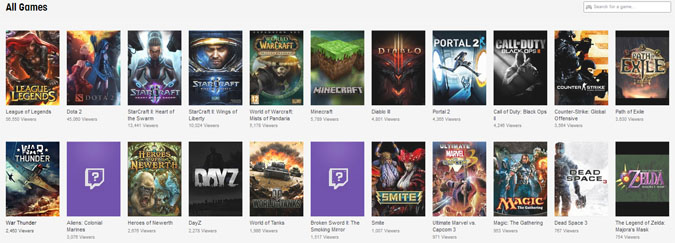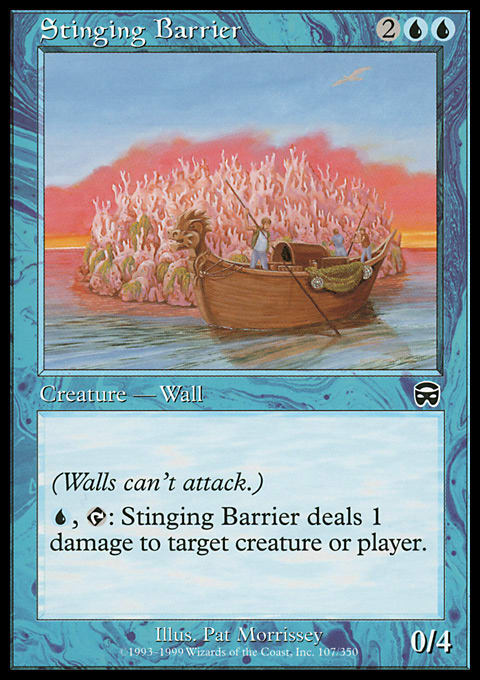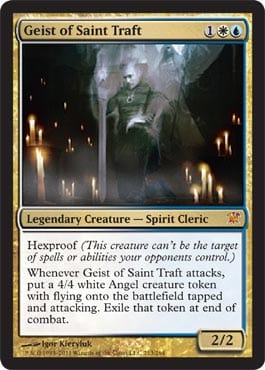I recently quit my job at a comic book store and can’t find another day job, thanks to a healthy blend of a comically inapplicable degree (Creative Writing) and a global economy that currently finds that all its money is on fire. So I have a lot of free time. With this time, I watch a lot of gamers streaming. I go to www.Twitch.tv almost every day. Here’s what I see:

That picture was taken February 12, 2013, at about quarter to two in the afternoon, EST, but it’s pretty representative of Twitch at any given time—a lots of people watching League of Legends, Dota 2 (whatever that is), Diablo 3, World of Warcraft, and a game called Path of Exile that, were I to pick it up, I would only ever be able to call Path to Exile.
Wait a minute.
Where’s Magic? Surely Magic can have more than four thousand viewers, even on a weekday, right? I mean, who wants to watch a bunch of latchkey kids spamming racial slurs play League of Legends anyway?1

At a little under a thousand viewers, Magic: The Gathering finds itself nestled comfortably between The Legend of Zelda: Majora’s Mask, a Nintendo 64 game from 2000, and Ultimate Marvel vs. Capcom 3, a game originally intended as a patch for an existing game.2
If you love Magic as much as I do, this is really depressing. You probably also realize that Cedric Phillips tackled this same issue a half a year ago, in an article that ended with the following sentiment:
The implied answer here is “no”; your friend would see grainy footage of two men quietly playing cards while two other unseen men in a commentator’s booth wonder aloud what’s in the players’ hands. The game would end, some more talking would happen between commentators, during which time viewers would ostensibly be able to experience the gamut of varying degrees of discomfort and/or boredom, and then another match would begin, and the cycle would begin anew.
Cedric’s thesis, however unstated, is basically that League of Legends coverage is awesome and that Magic coverage needs to have production value and push player narratives, like League of Legends. Cedric talks about going to the North American regionals for League of Legends and being immediately drawn in to the drama of the David-versus-Goliath finals matchup. The implication here is that, while those select few players close to the pro scene know a lot of interesting personal anecdotes about players, Wizards of the Coast has largely shrugged off the idea that this is necessary for the pro Magic circuit.
Riot Games, the developers for League of Legends, have embraced the personal aspect of their top players’ lives, and they incorporate these players’ quirks and rivalries into the coverage.
#ShortAside
This is the part where I talk about the recent incorporation of Pro Tour team hash tags in the collective Magic consciousness. Short version: They make me feel icky. They feel like a marketing tool, because that’s what they are. I am slowly coming to the realization that while this stuff feels icky and sometimes even borderline obnoxious, narratives like the ones being crafted are important for people following the game, and we all ultimately want the same thing: for Magic to grow. A rising tide lifts all boats, you know.3
The player base for League of Legends is thirty-two million, compared to Magic’s twelve million.
Wow.
Let’s forget about viewer statistics for a minute. How does Magic, a game that’s been going strong since 1993, become so dwarfed in use by a computer game from 2009?
There are very real barriers to playing Magic, but I want to focus on two specific ones.
People play Magic instead of chess or poker because it’s an outlet for creativity and expression. It’s true—I promise. Even that degenerate Pro Tour Qualifier grinder who’s always fiending for a Money Draft and constantly reassuring you that he’s getting so much value—the only reason he plays Magic instead of poker is his need to express himself. If he didn’t have that, he would be playing poker; there’s way more money in poker. Anyway, what this means is that Magic is totally subjective—to a degree that no video game can really replicate. Proof of this: How many different types of Magic articles are there? As I’m writing this, there are thirteen articles on the front page of GatheringMagic.com, with eleven different types: infographic, Standard, a few casual (which in and of itself is completely subjective) articles, Commander (video), Standard on a budget, an article on how Ravnica is an allegory to the United States, Commander (text), a writing roundup, a deck roundup, an interview with a former Magic developer, and a financial article. I mention this because the simple fact that a game has a player base of twelve million doesn’t necessarily mean that twelve million people are going to want to watch a Pro Tour. Because Magic is so inherently expressive, everyone does something different with it. If you asked seven different players, “What’s the overall goal in Magic?” you’d probably hear seven different answers. What I’m getting at here is that the majority of Magic players are simply unlikely to care about the Pro Tour at all.
The cost of entry to Magic is very real and very high. To play League of Legends, all you really need is a computer. You can buy things on League of Legends, but the important thing to remember is that you can’t buy anything to get an edge over another player that you wouldn’t already be able to get by just playing the game. This is decidedly not true in Magic, especially in Constructed. The best cards are going to win every time, and the formats have various levels of cost entry. For a reference point, let’s price out Jon Stern’s Grand Prix–winning decklist from Atlantic City, since GP: Atlantic City was a Standard tournament and Standard is the cheapest Constructed format still played in paper.
| # | Card | Cost/Copy | Total Cost |
|---|---|---|---|
| 3 | Cavern of Souls | $23.99 | $71.97 |
| 4 | Forest | ||
| 1 | Glacial Fortress | $3.49 | $3.49 |
| 4 | Hallowed Fountain | $9.99 | $39.96 |
| 4 | Hinterland Harbor | $10.99 | $43.96 |
| 1 | Island | ||
| 2 | Sunpetal Grove | $4.99 | $9.98 |
| 4 | Temple Garden | $11.99 | $47.96 |
| 4 | Avacyn's Pilgrim | $0.45 | $1.80 |
| 4 | Geist of Saint Traft | $28.99 | $115.96 |
| 4 | Invisible Stalker | $2.49 | $9.80 |
| 3 | Silverblade Paladin | $9.49 | $28.47 |
| 4 | Abundant Growth | $0.20 | $0.80 |
| 4 | Ethereal Armor | $0.20 | $0.80 |
| 2 | Increasing Savagery | $2.99 | $5.98 |
| 4 | Rancor | $3.49 | $13.96 |
| 4 | Selesnya Charm | $1.25 | $5.00 |
| 4 | Spectral Flight | $0.20 | $0.80 |
| Sideboard | |||
| 1 | Angelic Overseer | $1.75 | $1.75 |
| 2 | Feeling of Dread | $0.25 | $0.50 |
| 2 | Loxodon Smiter | $3.49 | $6.98 |
| 3 | Nearheath Pilgrim | $0.25 | $0.75 |
| 1 | Negate | $0.25 | $0.25 |
| 2 | Nevermore | $0.75 | $1.50 |
| 3 | Rest in Peace | $1.99 | $5.97 |
| 1 | Rootborn Defenses | $0.25 | $0.25 |
| 75 | $419.65 | ||
All prices were taken from CoolStuffInc.com, using the lowest price I could find for each card. Bant Hexproof, one of the cheaper decks in all of Standard, will still run you upward of $400. The mana base alone clears $200. While it bears noting that it’s actually quite easy to recoup initial losses in Magic and even finish at a profit just by playing on Magic Online or your local game store, this still isn’t obvious to the uninitiated. They see the cost barrier of Magic, the lack of cost barrier of League of Legends, and from there, the choice is easy. I’m not saying I think pursuing League of Legends comes at no cost; the fact that I might know how to weigh opportunity cost and the value of my time4 doesn’t mean everyone does.
I don’t really want to go into the economies of either game because I don’t think it’s really necessary. An interesting article that will eventually be written by someone much more cynical than I will posit the idea that since WotC is a subsidiary of Hasbro, and therefore has stockholders to answer to, there is constant pressure to cut costs and increase profit margin, resulting in the scaling back of the Pro Tour we’re currently witnessing. It will also posit that Planeswalker Points were conceived as soon as someone in a high place realized that, in certain cases under the Elo system, players could actually benefit from abstaining from a tournament.
But that’s too cynical for me.
What do I think is wrong with coverage? I honestly don’t know. I don’t watch enough Grand Prix coverage to know how to fix it. That’s why I’ll be live-blogging all the coverage of PT: Montreal I can handle, all the while trying to address each misstep I see as they come. So look for that next week, and feel free to watch the coverage yourself so we can have a discussion about it in the comments. Sound good?
See you next week!
Jon Corpora
Pronounced Ca-pora
1 I believe that sentence just aged me by approximately fifty years.
2 Imagine my surprise when I go to the game’s Wikipedia website in the hopes that some snarky joke will come to me, only to find that it was originally intended as DLC. Holy shit.
3 Oh, yes, I know I linked to an SCG-aggrandizing Evan Erwin tweet in the same paragraph that I linked to one of my own articles. Trust me; the irony is not lost on me.
4 I do play Magic, so, y’know, maybe I don’t know shit about any of that stuff.



























